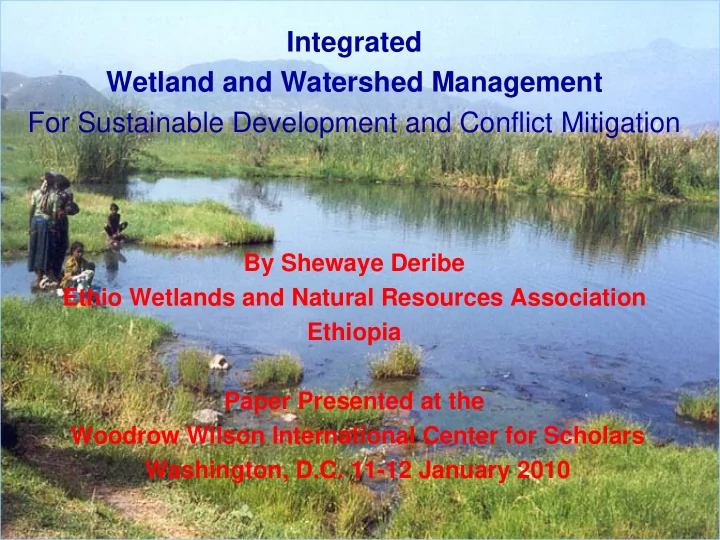

Integrated Wetland and Watershed Management For Sustainable Development and Conflict Mitigation By Shewaye Deribe Ethio Wetlands and Natural Resources Association Ethiopia Paper Presented at the Woodrow Wilson International Center for Scholars Washington, D.C. 11-12 January 2010
CONTENT 1. Introduction – Environment – People – Conflict sources 2. Practices to sustainability
Population Growth and Environmental Change Government, economy, Water and food security Biodiversity Conservation/ Climate change Crop-Forest Landless community continuum members Conflict of ideas, interests Investors and benefits
Environment and Conflicts • Rapid population growth and poverty • Environmental degradation and livelihood insecurity • Despair , migration and conflicts
Then ?
Land Degradation & Climate Change Loss of assets- livestock and crop failure- unpredictable future- creates fertile ground for conflicts
Increasing competition for dwindling resources Shortage of fish and severe competition Burden on women
Pollution and Health
Ecosystem wellbeing improves quantity and quality of resources Resource availability hampers conflicts Blue Nile -Flourishing
Ecosystem degradation leads to resource shortage both in quality and quantity Resource shortage stimulates grievance and conflicts Blue Nile-shrinking
Harmonize linkages between people and environment • Build local capacity and encourage participation • Partnership (government-private-CBOs; upstream-down stream ) • Balance population growth and carrying capacity • Realize fair benefit sharing (ownership, sustainability)
Biosphere ( Biodiversity, w ater, land, energy ,air) Harm onize People- Biosphere interaction Hum an Com m unities
The Experience of Ethio Wetlands and Natural Resources Association Integrated Watershed Management • to protect the environment and • mitigate associated conflicts
The Experience of EWNRA • Capacity building (Awareness and Training) • Wetland-Watershed Rehabilitation • Livelihood diversification • Water and Sanitation • Reproductive Health –FP • Energy Efficient Technology • Environmental Policy Advocacy
Improve Watershed Productivity by Vetiver grass and compost
E nvironment, Livelihood, Food, etc . ALTERNATIVE LIVELIHOOD: Employment and Revolving fund
Environment, Livelihood, Food, etc Bee keeping and fattening
Environment, Livelihood, Food, etc Afforestation and Agro-forestry
-Safe guard community health -Reduce burden of women
-Reduce biomass consumption for fuel -Protect women’s health -Save their time and energy
Community/ Consensus and trust-building • Sensitization, discussions on stakeholders problems and solutions Environment Community-Donor Expert visit and Community-decision Interaction learning makers field day Awareness Expert training Planning
PROJECT ACHIEVEMENTS Livelihood-Dependence on Natural resources decreasing Health-Nutritional, Family Planning and water born infections Environmental- better function and services Behavioural- community stewardship growing Institutional-Watershed committees with bylaws General- Secured trust from the community & other stakeholders
Rehabilitated Wetland of Wichi
CONCLUSION Integrated approach is advantageous t o • Improve the environment, livelihood and resilience of poor communities with minimum cost • Block opportunities to migration, unrest and conflicts Scale up programmes that integrate • Population, • Health • Livelihood and • Environment issues at watershed level
Recommend
More recommend